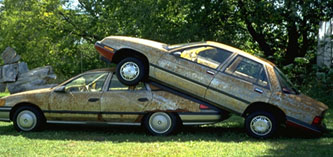There’s No Place Like Home
Jeffrey Kalstrom writes on Franconia Sculpture Park, the homeland for sculpture


“When it’s too dark to work” is the answer given to Franconia Sculpture Park newcomers who ask “When is dinner?”
Franconia was created to give sculptors the tools, space, and opportunity to work hard, big, experimental, and for as long as they can stand up. All the work is done outdoors, and a rainy day at Franconia can devolve into a sad, smelly spectacle of sculptors and their wet dogs huddled inside watching Blade Runner and smoking in the afternoon. On particularly hot days a late afternoon dip in the nearby St. Croix river is a must.
Dinner at Franconia is legendary, with vegetables and herbs from the kitchen garden maintained by co-founder Tasha Hock. Interns and artists rotate the performance of the dinner, which results in cuisine with global reach. During one memorable stay I had New-Orleans-style chicken-fried steak and homemade macaroni ‘n cheese with peach cobbler, the next day innumerable UK-style curries, and on the third day flaming venison on the grill, a la Minnesota.
On occasion visiting luminaries are in attendance, such as when Dutch artist/visionary/architect Joep van Lieshout took a break from working at the Walker and dined with the company. After dinner a chaotic round of discussion and debate often ensues, occasionally lapsing into singing, bouts of fire eating, and other performative excesses. After an iron pour last summer someone brought out a bag of a hundred Frisbees, which lead to an aerial battle and a few bruises the next day. Sculptors love fire (viz. their penchant for inhaling burning sticks of tobacco) and so massive bonfires sometimes bring a soothing end to the day. When the mosquitoes drive everyone indoors dancing may occur, facilitated by the disco ball that hangs from the living room ceiling.
The focus at Franconia is on the needs of the artist. Unlike some sculpture parks the emphasis here is less on giving the public a polished presentation than it is on showing them artists at work. Franconia was founded seven years ago as a nonprofit by John Hock (park director, spiritual leader, and dad), Tasha Hock, and Fuller Cowles. Hock has worked with both Mark di Suvero and Sir Anthony Caro. His experience working at Socrates Sculpture Park in NYC led him to see the need for more parks organized by artists for artists.
Franconia is located about 45 minutes northeast of Mpls./St. Paul. Much of the staff are interns: sculpture-mad college students who spend half their time assisting the visiting artists fabricate their work and half their time on their own work, using the cranes, fork lifts, gantries, trucks, trailers, nailers, and more mig, tig, and pig welders than you can shake a stick at.
Typically two to four sculptors are working at Franconia at one time, often working in ways that they may not have worked before. In contrast to the solitude of the studio, here you work cheek and jowl with other artists and you have assistants–which means designating tasks and not doing everything exactly your way. Also, Franconia is open 365, 24/7. Members of the public are always coming up to you and inquiring, “what cha makin?” You need to figure out how to make the on-the-face-of-it-absurdity of what you’re doing seem sensible, important, and interesting, in plain language.
The roughly 75 sculptures at Franconia are there temporarily– usually for one year. Most of the work is made on site and the best bears the mark of it. One current work which speaks to the urban/rural is a work by Tamsie Ringler entitled Landing on Eros, two rusting hulks of Detroit steel humping in a field of green. The insides of both cars have been entirely emptied/cut open/fused and the resulting shared interior space entirely gold-leafed. With their headlights on and their radios playing, it’s all about love, sex, and steel ponies.
A recent work is Jean Humkes’ Comfort, combining photography, performance, and sculpture. Last fall she dug a grave-like hole in the ground, laid in it nude, and had a 2-ton steel plate lowered over the hole. The plate had a square cut out of the middle just large enough to reveal her belly. In the spring at the Minneapolis College of Art and Design she arranged a bed of white chrysanthemums in the same square shape and size as the steel plate and laid on it–naked as well–in the gallery, leaving for the duration of the show her body’s impression in the bed of flowers. At Franconia the bed of chrysanthemums and the steel plate lie horizontal, separated by two vertically mounted life-sized photographs on vinyl of her dual performances. Even for viewers with no knowledge of the performances, the sculpture opens up juicy thoughts about the physical embodiment of life and death, desire and revulsion. It is work like this, in this rural setting, that makes the power and potential of Franconia evident.
This is a version of a piece published in the final issue of the New Art Examiner, republished here by permission.